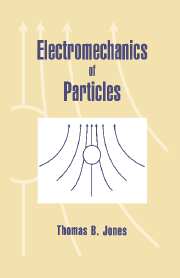Book contents
- Frontmatter
- Contents
- Preface
- Nomenclature
- 1 Introduction
- 2 Fundamentals
- 3 Dielectrophoresis and magnetophoresis
- 4 Particle rotation
- 5 Orientation of nonspherical particles
- 6 Theory of particle chains
- 7 Force interactions between particles
- Appendix A Analogies between electrostatic, conduction, and magnetostatic problems
- Appendix B Review of linear multipoles
- Appendix C Models for layered spherical particles
- Appendix D Transient response of ohmic dielectric sphere to a suddenly applied DC electric field
- Appendix E Relationship of DEP and ROT spectra
- Appendix F General multipolar theory
- Appendix G Induced effective moment of dielectric ellipsoid
- References
- Index
4 - Particle rotation
Published online by Cambridge University Press: 02 December 2009
- Frontmatter
- Contents
- Preface
- Nomenclature
- 1 Introduction
- 2 Fundamentals
- 3 Dielectrophoresis and magnetophoresis
- 4 Particle rotation
- 5 Orientation of nonspherical particles
- 6 Theory of particle chains
- 7 Force interactions between particles
- Appendix A Analogies between electrostatic, conduction, and magnetostatic problems
- Appendix B Review of linear multipoles
- Appendix C Models for layered spherical particles
- Appendix D Transient response of ohmic dielectric sphere to a suddenly applied DC electric field
- Appendix E Relationship of DEP and ROT spectra
- Appendix F General multipolar theory
- Appendix G Induced effective moment of dielectric ellipsoid
- References
- Index
Summary
Introduction
As early as 1892, Arno reported that small particles can be made to spin when placed in a rotating electric field. This rotation is not synchronous; the angular velocity of the particle depends on the electric field magnitude squared. In recognition of significant later contributions made by Born (1920) and Lertes (1920, 1921), this phenomenon has become known as the Born–Lertes effect. Shortly after Arno's work, Weiler (1893) discovered the related phenomenon that small solid particles suspended in liquids can rotate in a static electric field. Though Weiler published first, this effect has come to be known as Quincke rotation (Quincke, 1896). Unlike the Born–Lertes effect, Quincke rotation is a threshold phenomenon; spontaneous rotation occurs once the field strength is increased above some critical value. The rotational axis is always perpendicular to the imposed electric field for both effects. Pickard (1961) reviewed and clarified these phenomena, emphasizing the close relationship of the two effects. This chapter illuminates this relationship, relying on the effective moment method, viz. Equation (2.6), for calculation of the torque of electrical origin.
Electrically induced particle rotation provides one explanation for the observed disruption that sometimes occurs during the initial chain formation step of electrofusion procedures (Holzapfel et al., 1982). If the linearly polarized AC electric field is within certain limited frequency ranges, linear chains of cells deform into irregular corkscrew configurations that interfere with electrofusion protocols. In some cases, the cells from disrupted chains spin steadily in the presence of the electric field. Zimmermann and Vienken (1982) hypothesized that this field-induced rotation, evident only when cells are proximate to one another, is responsible for the frequency-dependent disruption of chains.
Information
- Type
- Chapter
- Information
- Electromechanics of Particles , pp. 83 - 109Publisher: Cambridge University PressPrint publication year: 1995
